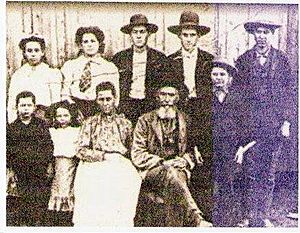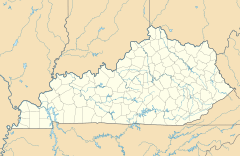Scuffletown, Henderson County, Kentucky facts for kids
Quick facts for kids
Scuffletown
|
|
|---|---|
| Country | United States |
| State | Kentucky |
| County | Henderson |
| Elevation | 374 ft (114 m) |
| Time zone | UTC-6 (Central (CST)) |
| • Summer (DST) | UTC-5 (CST) |
| GNIS feature ID | 509024 |
Scuffletown is a ghost town located in Henderson County, in the western part of Kentucky. It sits right on the Ohio River, near where the Green River flows into it. Scuffletown was a busy town for about 100 years. It is well-known in the area because of events that happened there during the American Civil War.
Contents
Where is Scuffletown?
Today, the area is called Scuffletown Bottoms. It is located on the border between Kentucky and Indiana. It is almost directly across the Ohio River from Newburgh. You can find it in the northeastern part of Henderson County, Kentucky.
The Story of Scuffletown
How Scuffletown Began
Scuffletown started around 1800. A man named Jonathan Thomas Scott, also known as Scott Fox, married Mary Polly Cooper. Scott Fox was believed to be the son of a Shawnee leader named Cornstalk. Mary Polly Cooper was Cherokee. They had two sons, Jonathan and Thomas.
Scott Fox ran a tavern in the area. It was easy for people traveling on the river to stop there. In 1838, he was shot and killed in Shawneetown, Illinois. His great-great-grandson, Michael "Manfox" Buley, still lives in Henderson County today.
How Scuffletown Got Its Name
The town got its unique name from the people who traveled on flatboats down the Ohio River. The Cherokee people who lived there enjoyed playing stickball and having wrestling matches. They held these games right outside the tavern and trading post.
White travelers saw these games as "scuffling." According to a book called Annals and Scandals of Henderson County, the tavern always had plenty of drinks. This made it a popular meeting spot for flatboatmen and others on the river. Often, after hours of drinking, a big fight would start. Because of these frequent "scuffles," the place became known as Scuffletown.
Early Buildings and Businesses
A school was built in Scuffletown around 1817. The first church was built in 1830 on the Vanada farm. In 1860, a tobacco stemmery was built. This business prepared tobacco and shipped large amounts (400 to 450 hogsheads) to Europe each year. Soon after, a steam gristmill and a blacksmith shop were also built. Besides growing tobacco and corn, Scuffletown was also known for its many pecan trees.

Scuffletown During the Civil War
Scuffletown was a busy place during the American Civil War. Many important events happened there. For example, a large steamboat called the Silver Lake No. 2 would stop at Scuffletown. This boat weighed 129 tons and had six cannons that could fire heavy shots. It patrolled the Ohio River.
In 1863, eight companies of Union infantry (foot soldiers) and one company of artillery (soldiers with cannons) were stationed in Scuffletown. Their job was to protect the area from Confederate raiders. Scuffletown is even mentioned in a Civil War story about "Operations of the Mississippi Squadron during Morgan's Raid."
Cherokee Community in Scuffletown
Later in the 1800s, a man named James Martin led a group of Cherokee people to the area. They were refugees from Fort Smith, Arkansas. They came to join their relatives who were already living in the Scuffletown area.
On December 26, 1893, the Governor of Kentucky, John Y. Brown, officially welcomed this group as an Indian tribe. Over the years, the descendants of these Cherokee people have kept their culture and traditions alive. At least twice a year, members of the tribe meet in different places nearby to perform their sacred ceremonies.
The Decline of Scuffletown
In 1895, an atlas showed that downtown Scuffletown had a population of 71 people. By 1868, Scuffletown had grown enough to get its own post office.
However, a big flood in 1913 caused a lot of damage to the city. Many people left, and the town never fully recovered. Its post office closed for good in January 1914. Then, an even larger flood in 1937 destroyed most of what was left. Since then, Scuffletown has been mostly empty. The area is now simply called Scuffletown Bottoms.
A New Purpose for Scuffletown Bottoms
On January 18, 2001, the U.S. Fish and Wildlife Service suggested creating a national wildlife refuge in the Scuffletown Bottoms. The goal of this refuge is to protect and restore important wetland habitats. These wetlands are vital for migrating and wintering waterfowl (like ducks and geese), other birds, and native fish and wildlife.
The Kentucky Oral History Sound Recordings project has also recorded conversations with people who used to live in Scuffletown. These recordings are kept at the Henderson County Public Library. They help us learn more about the history of this unique place.


